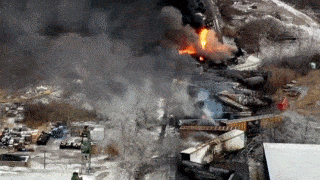EAST PALESTINE, Ohio — For nearly one year, East Palestine has been dealing with the fallout of a fiery train derailment. While neighbors and business owners grapple with the short-term effects and long-term concerns, Ohio officials are touting the progress made since February 2023.

We don’t just report the initial story—we follow through to its conclusion. Read and watch our previous reporting on this story below and see more stories that we've followed through on here.
“It’s been pretty crazy. [There have been] all kinds of people in the area, all kinds of people running tests and that,” said William “Smiley” Hugar.
Coworkers coined the nickname for Hugar’s good-natured grin and he immortalized it with a tattooed yellow smiley face over crossbones. The image on his bicep peeked out from Hugar’s t-shirt as he pointed to the property behind his backyard.
“This is a part of town where no one messed around at. So it was pretty peaceful,” he said. “This used to be a city. Now I call it the ‘ghost town’ of East Palestine.”
Hugar lives in his childhood home less than a half mile from the Ohio-Pennsylvania border and just several hundred yards from where a now infamous train derailed on February 3, 2023.
“All the railroad tracks behind us, down to the first crossing, were on fire,” he recalled.
The Norfolk Southern train was carrying toxic chemicals. In an effort to prevent an explosion, first responders evacuated part of the town before venting and burning 5 rail cars full of vinyl chloride.
“We had a constant breeze at the time that just blew everything that way,” Hugar said, pointing East. “We are lucky. No one got hurt.”
The material spilled during the derailment and vaporized during the controlled burn have prompted health and environmental concerns. The resulting loss of visitors, business and property values have led to economic consequences.
“People want to get out,” Hugar said. “They don’t know what’s going to happen next.”
Disaster mitigation in East Palestine started immediately after the derailment. In the months since it happened, state agencies said they’ve had a nearly constant presence in the town.
“A year is a long time and it’s been a lot of work. But it’s also been pretty remarkable how much has happened in a year,” said Ohio EPA director Anne Vogel.
Vogel offered an update on the progress Wednesday as the derailment nears its first anniversary.
"This is not going to be a long-term contaminated town. It's just not. It was a contained area, we know exactly what was spilled and in what quantities. And we know how to clean it up. This is what we do," she said.
She said the Ohio EPA, along with Norfolk Southern, the U.S. EPA and other agencies have removed at least 160,000 tons of contaminated soil and 39 million gallons of liquid waste from the derailment site.
They finished the removal in October and have since been focusing on a restoration phase, including backfilling nearly 6 football fields worth of soil. Vogel said the agencies and railroad have also been monitoring air, soil and water quality and focusing on keeping contamination out of several nearby streams.
“We’ve got the best scientists from around the country looking at these plans,” she said.
Despite skepticism from some residents, Vogel said there are currently no signs of ongoing public risks. She explained Norfolk Southern will be responsible for additional remediation if sampling uncovers anything concerning.
“We will always be protective of human health and the environment in East Palestine,” she added.
Hugar said he worries about the town’s future and reputation and plans to monitor his own health. He praised the ongoing testing and remediation, though he hopes for the future when it’s not necessary.
“I’m just waiting for the normalcy to come back, where we don’t have trucks back here all the time and people working back on the tracks,” he said. “Peace and quiet again.”






